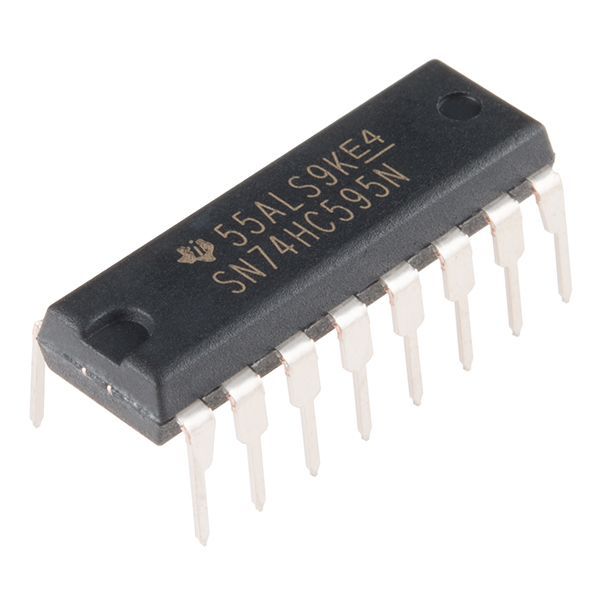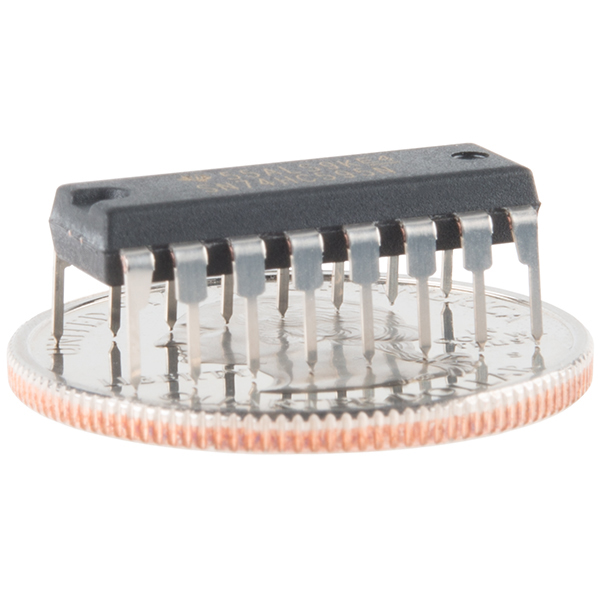The SN74HC595N is a simple 8-bit shift register IC. Simply put, this shift register is a device that allows additional inputs or outputs to be added to a microcontroller by converting data between parallel and serial formats. Your chosen microprocessor is able to communicate with the The SN74HC595N using serial information then gathers or outputs information in a parallel (multi-pin) format. Essentially it takes 8 bits from the serial input and then outputs them to 8 pins.
This small DIP packaged IC contains an 8-bit, serial-in parallel-out shift register that feeds an 8-bit D-type storage register with parallel 3-state outputs.
Note: This is a drop-in replacement for the 74HC595 shift register IC and should function just fine in any application the previous version could.
- 8-Bit Serial-In, Parallel-Out Shift
- Wide Operating Voltage Range of 2 V to 6 V
- High-Current 3-State Outputs Can Drive Up to 15 LSTTL Loads
- Low Power Consumption: 80-μA
- ±6-mA Output Drive at 5 V
- Datasheet
- Shift Register Tutorial
- 7-Segment Library (Thanks Quin!)
Shift Register 8-Bit - SN74HC595 Product Help and Resources
Experiment Guide for the Johnny-Five Inventor's Kit
June 28, 2016
Use the Tessel 2 and the Johnny Five Inventors kit to explore the world of JavaScript enabled hardware through 14 awesome experiments!
Core Skill: Programming
If a board needs code or communicates somehow, you're going to need to know how to program or interface with it. The programming skill is all about communication and code.
Skill Level: Rookie - You will need a better fundamental understand of what code is, and how it works. You will be using beginner-level software and development tools like Arduino. You will be dealing directly with code, but numerous examples and libraries are available. Sensors or shields will communicate with serial or TTL.
See all skill levels
Core Skill: Electrical Prototyping
If it requires power, you need to know how much, what all the pins do, and how to hook it up. You may need to reference datasheets, schematics, and know the ins and outs of electronics.
Skill Level: Competent - You will be required to reference a datasheet or schematic to know how to use a component. Your knowledge of a datasheet will only require basic features like power requirements, pinouts, or communications type. Also, you may need a power supply that?s greater than 12V or more than 1A worth of current.
See all skill levels
Comments
Looking for answers to technical questions?
We welcome your comments and suggestions below. However, if you are looking for solutions to technical questions please see our Technical Assistance page.
Customer Reviews
No reviews yet.



-------------------- Tech Support Tips/Troubleshooting/Common Issues --------------------
Additional tutorials: For an additional tutorial example, try looking at bildr's tutorial for adding daisy chaining the 74HC595s as stated at the bottom of the SFE Shift Register tutorial: http://bildr.org/2011/02/74hc595/ .
You have a typo in the description. "Simply put, this shift register is a device that allows additional inputs or outputs to be added to a microcontroller by converting data between parallel and serial formats." This shift register cannot function as a shift-in register and therefore does not add additional inputs.
There actually is a way to use this to expand your inputs, you sacrifice some speed to do it but it is possible.
https://youtu.be/nXl4fb_LbcI
Great resource! BTW, you can find both schematics and source code for 1 Shift Register (4 outputs, 4 inputs); 2 SRs (8 outputs, 8 inputs) and 3 SRs at this GitHub repo.
Wish I had read this earlier... Please note this Sparkfun
would have been happier if the connections and coding were shown from the scratch, just a noob.